
Scorpions are predatory arachnids of the order Scorpiones. They have eight legs, and are easily recognized by a pair of grasping pincers and a narrow, segmented tail, often carried in a characteristic forward curve over the back and always ending with a stinger. The evolutionary history of scorpions goes back 435 million years. They mainly live in deserts but have adapted to a wide range of environmental conditions, and can be found on all continents except Antarctica. There are over 2,500 described species, with 22 extant (living) families recognized to date. Their taxonomy is being revised to account for 21st-century genomic studies.

Palpigradi is an order of very small arachnids commonly known as microwhip scorpion or palpigrades.

Uropygi is an arachnid order comprising invertebrates commonly known as whip scorpions or vinegaroons. They are often called uropygids. The name "whip scorpion" refers to their resemblance to true scorpions and possession of a whiplike tail, and "vinegaroon" refers to their ability when attacked to discharge an offensive, vinegar-smelling liquid, which contains acetic acid. The order may also be called Thelyphonida. Both names, Uropygi and Thelyphonida, may be used either in a narrow sense for the order of whip scorpions, or in a broad sense which includes the order Schizomida.

Solifugae is an order of animals in the class Arachnida known variously as camel spiders, wind scorpions, sun spiders, or solifuges. The order includes more than 1,000 described species in about 147 genera. Despite the common names, they are neither true scorpions, nor true spiders. Most species of Solifugae live in dry climates and feed opportunistically on ground-dwelling arthropods and other small animals. The largest species grow to a length of 12–15 cm (5–6 in), including legs. A number of urban legends exaggerate the size and speed of the Solifugae, and their potential danger to humans, which is negligible.
The lesser stripetail scorpion is a small (35-55mm) species of scorpion found in Mexico and the southwestern United States.

The Arizona bark scorpion is a small light brown scorpion common to the Sonoran Desert in the southwestern United States and northwestern Mexico. An adult male can reach 8 cm in length (3.14 inches), while a female is slightly smaller, with a maximum length of 7 cm (2.75 inches).

Capsicum chinense, commonly known as a "habanero-type pepper", is a species of chili pepper native to the Americas. C. chinense varieties are well known for their unique flavors and many have exceptional heat. The hottest peppers in the world are members of this species, with Scoville Heat Unit scores of over 2 million. Some taxonomists consider them to be part of the species C. annuum, and they are a member of the C. annuum complex; however, C. chinense and C. annuum pepper plants can sometimes be distinguished by the number of flowers or fruit per node – two to five for C. chinense and one for C. annuum – though this method is not always correct. The two species can also hybridize and generate inter-specific hybrids. It is believed that C. frutescens is the ancestor to the C. chinense species.

Nepidae is a family of exclusively aquatic Heteropteran insects in the order Hemiptera. They are commonly called water scorpions for their superficial resemblance to scorpions, due to their raptorial forelegs and the presence of a long slender process at the posterior end of the abdomen, resembling a tail. There are 14 genera in the family, in two subfamilies, Nepinae and Ranatrinae. Members of the genus Ranatra, the most widespread and species-rich genus, are sometimes called needle bugs or water stick insects as they are slenderer than Nepa.

The collared peccary is a species of artiodactyl (even-toed) mammal in the family Tayassuidae found in North, Central, and South America. It is the only member of the genus Dicotyles. They are commonly referred to as javelina, saíno, or báquiro, although these terms are also used to describe other species in the family. The species is also known as the musk hog. In Trinidad, it is colloquially known as quenk.

Hadrurus arizonensis, the giant desert hairy scorpion, giant hairy scorpion, or Arizona Desert hairy scorpion is a large scorpion found in North America.
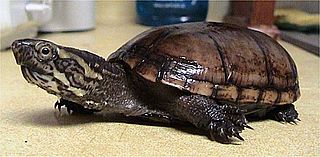
Kinosternon is a genus of small aquatic turtles from the Americas known commonly as mud turtles.
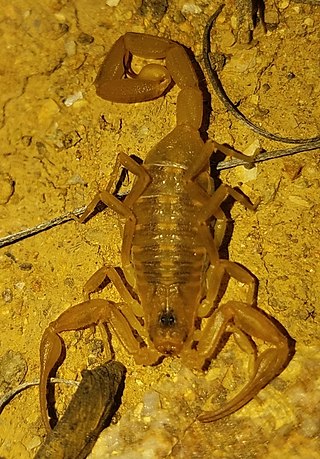
Centruroides exilicauda, the Baja California bark scorpion, is a species of bark scorpion found in Baja California. It is closely related to the Arizona bark scorpion, but is not considered dangerous. Previously only distinguished by geographic range, the two variants were classified in 1980 as the same species. Subsequently, differences in venom toxicity were recorded, and in 2004, DNA analysis showed them to be separate species. The Baja California bark scorpion is a slender, long-tailed scorpion, and although it is typically sand-colored it appears in darker colors.
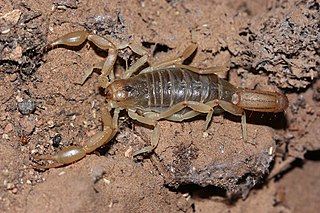
Paravaejovis spinigerus, commonly known as the stripe-tailed scorpion or devil scorpion, is a species of scorpion in the family Vaejovidae. It is found in the south-western United States and north-western Mexico.
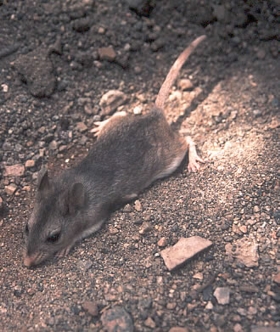
The southern grasshopper mouse or scorpion mouse is a species of predatory rodent in the family Cricetidae, native to Mexico and the states of Arizona, California, Nevada, New Mexico, and Utah in the United States. Notable for its resistance to venom, it routinely preys on the highly venomous Arizona bark scorpion.

Vaejovidae is a family of scorpions, comprising 25 genera and 227 species, found in North America. The species of the genus are found in Mexico and the southern United States, and Paruroctonus boreus is found in Canada and is the northernmost species of scorpion in the world.
Vaejovis brysoni is a species of scorpions belonging to the family Vaejovidae discovered in 2013 in the Santa Catalina Mountains of southern Arizona. It was reportedly discovered in an area that overlooks the city of Tucson by Robert W. Bryson Jr., after whom the species is named. At the date of its discovery it became the tenth species of mountain scorpion known to occur in Arizona, and the second in the vorhiesi group to inhabit the specific mountain range.

Paruroctonus silvestrii, the California common scorpion, is a species of scorpion in the family Vaejovidae.

Paruroctonus is a genus of scorpions in the family Vaejovidae. There are about 10 described species in Paruroctonus.
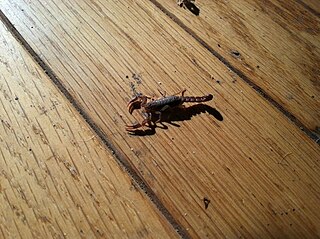
Vaejovis carolinianus, the Southern Unstriped Scorpion, also known as the Southern Devil Scorpion, is a species of scorpion in the family Vaejovidae.

Afrolychas braueri, commonly known as the Seychelles forest scorpion, is a species of scorpion in the family Buthidae. It is currently thought to survive only on Silhouette Island, Seychelles, although the species was historically found on two additional Seychellois islands. This scorpion lives in leaf litter in forests that are largely unaffected by invasive plant species. It is a small yellowish-brown scorpion with three prominent keels on the dorsal surface of its mesosoma, which distinguishes it from other scorpions. While not much is known about the Seychelles forest scorpion's ecology due to the paucity of sightings, it is known to rely solely on its venom to capture its prey and defend its young. Its venom is not dangerous to humans.
















